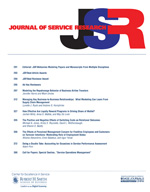Do Incentives Increase Word of Mouth?
Editor’s note: We are pleased to welcome Jochen Wirtz of the National University of Singapore, Chiara Orsingher of the University of Bologna, Patricia Chew of SIM University, and Siok Kuan Tambyah of the National University of Singapore, who published “The Role of Metaperception on the Effectiveness of Referral Reward Programs” in the Journal of Service Research.
 We were inspired to work on this topic due to an eye-opening incident at an advisory board meeting of an EMBA program one of the authors was a member of. The manager of that EMBA program suggested giving a high-end branded fountain pen to every alumni who would recommend this EMBA program to friends and
We were inspired to work on this topic due to an eye-opening incident at an advisory board meeting of an EMBA program one of the authors was a member of. The manager of that EMBA program suggested giving a high-end branded fountain pen to every alumni who would recommend this EMBA program to friends and  colleagues who then would apply to the program. To the manager’s (and author’s) surprise, the EMBA advisory board was up in arms over this proposal. They were unanimous in stating that they want to help the program, are not in this for any kind of benefit, would recommend the program already anyway to potential participants they considered suitable, and importantly, would definitely not want to be seen to benefiting in any way from their friends’ and colleagues’ potential joining of the program. The author was familiar with the word-of-mouth literature and knew that there was hardly any research that would explain such a negative reaction to a benefit offered to current customers. This triggered the interest to dig deeper, which then started this stream of research. The rationale of the paper and its findings are explained below.
colleagues who then would apply to the program. To the manager’s (and author’s) surprise, the EMBA advisory board was up in arms over this proposal. They were unanimous in stating that they want to help the program, are not in this for any kind of benefit, would recommend the program already anyway to potential participants they considered suitable, and importantly, would definitely not want to be seen to benefiting in any way from their friends’ and colleagues’ potential joining of the program. The author was familiar with the word-of-mouth literature and knew that there was hardly any research that would explain such a negative reaction to a benefit offered to current customers. This triggered the interest to dig deeper, which then started this stream of research. The rationale of the paper and its findings are explained below.
Today, many service firms operate Referral Rewards Programs (RRP) because they assume such programs will attract new customers, in analogy to what happens with word-of-mouth (WOM) recommendations. At first glance, incentives seem to be an effective way to encourage WOM and referrals. However, they may be in conflict with the perceived objectivity of WOM; incentives provide the recommender with a stake in the receiver’s potential purchase decision and may therefore make the recommendation seem less impartial. Our study analyzes how RRPs’ affect recommendation behavior. We suggest that when recommenders are offered the opportunity of receiving an incentive for a referral, they are likely to engage in a process of metaperception, defined in social psychology as the process by which people judge what others may think of them or their behaviors. If the recommender believes that the potential receiver views the incentivized recommendation favorably, she will be more likely to make that recommendation. If not, recommendation behavior is less likely.
Our findings show that RRPs’ do not work in all circumstances. Incentives can have a positive, neutral and negative effect on recommendation behavior depending on the relative strengths of the negative indirect effect of incentive on recommendation behavior via metaperception, and the positive effect of the perceived attractiveness of the incentive on recommendation behavior. Additionally, when incentives are involved, metaperception favorability decreases more for weak than for strong ties. This suggests that in a strong tie relationship, a recommender is likely to think that a referral reward is not going to alter the judgment that the receiver has of the recommendation but that it does so for weak ties.
For practice, our findings suggests firms to avoid providing incentives to customer with high positive impression management needs and rather emphasize other benefits of providing WOM and making recommendations (e.g., “do something good for the cause”, “for your friend”, or “for the EMBA program” as shown in our introduction). Moreover, we recommend targeting RRPs at strong rather than weak ties because of the lower negative effects of incentives on metaperception. For example, mobile phone companies could target college roommates, families with family plans. When targeting weak ties, managers should be aware that incentives need to be attractive enough to override their possible negative effect on metaperception.
Future research should focus on different distributions of incentives to see if they would help to counter the unfavorable metaperception (for example, if both the recommendation giver and recipient were to receive an incentive, then the metaperception of the recommendation might be less unfavorable). Moreover, future research should experimentally separate the face value of an incentive (i.e., its objective value) from its attractiveness (i.e., its subjective value) to the respondent. It seems likely that the face value drives metaperception, whereas the perceived attractiveness of the reward motivates recommendation behavior. If so, firms would have to become cognizant of the interplay between face value and the utility of the incentives, as increasing the face value of a reward with low utility could have a negative effect on recommendation behavior.


































































































